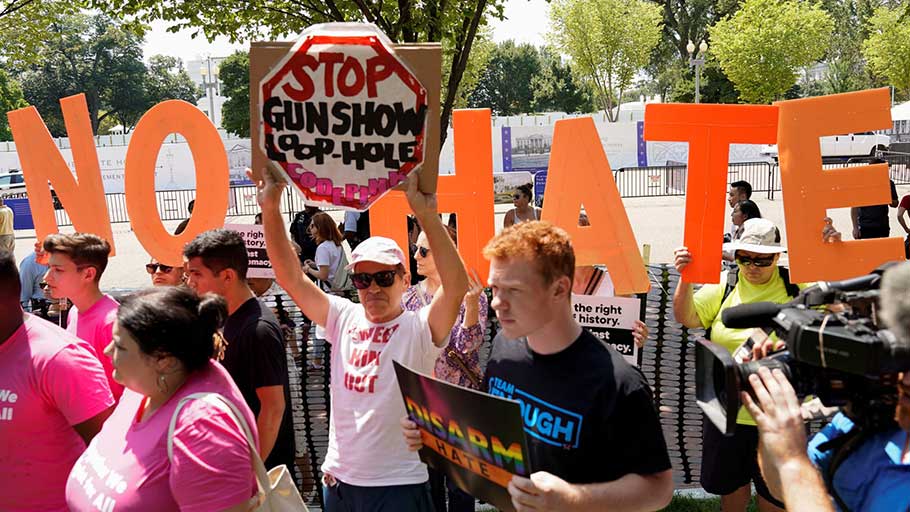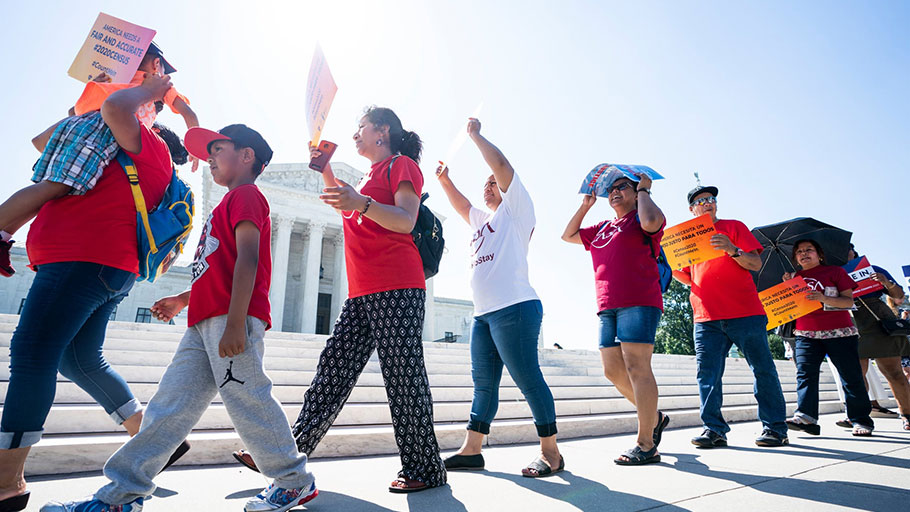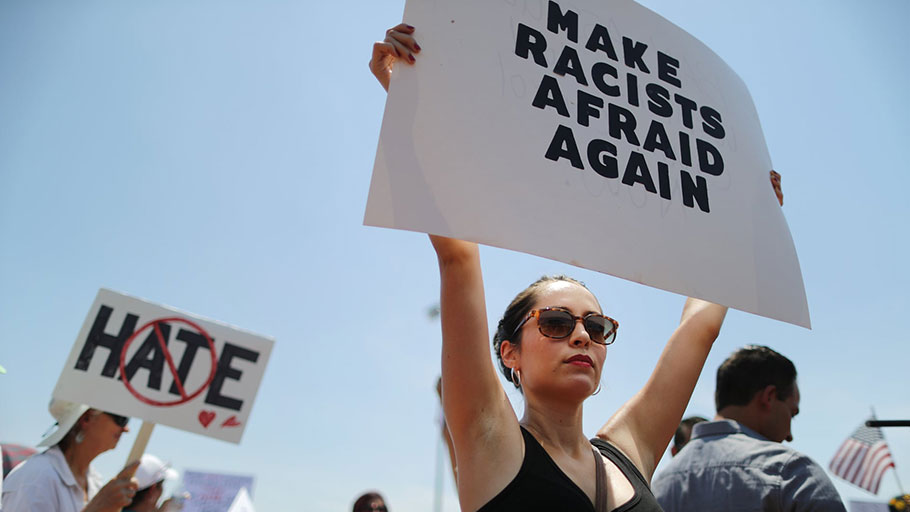The same anxiety that drives white supremacists has motivated Republicans to disenfranchise populations that don’t vote for them.
Before he opened fire on an El Paso, Texas shopping center, killing 22 people and injuring dozens more, the accused gunman, Patrick Crusius, allegedly posted a manifesto online explicitly stating his motivation: he was trying to stop a “Hispanic invasion of Texas”. In April, another shooter attacked a synagogue in Poway, California, killing one woman and wounding three other people. In his a “manifesto” attributed to him, he claimed he was responding to the “meticulously planned genocide of the European race”.
In Pittsburgh, Pennsylvania, in October 2018, still another shooter attacked a synagogue that he chose deliberately because the congregation helped with refugee relocation. He wrote online that they were trying to “bring invaders in that kill our people”. The man who murdered 51 people at two mosques in Christchurch, New Zealand, earlier this year, called immigration an “assault on the European people”..
All of these shooters were obsessed with the “great replacement” conspiracy theory, sometimes referred to as “white genocide”. It’s the idea that shadowy elites – usually Jewish, almost always liberal – are orchestrating the destruction of white culture through demographic change. The theory goes that white culture will be eroded mainly through migration and birthrates: more people of color are arriving in majority white counties, the ones already there are having more and more babies, and birthrates are declining for the soon-to-be-oppressed white people.
But the fans of this theory, and the idea of a demographic threat to a white (male) hierarchical structure, are no longer the preserve of extremists that lurk in the netherworlds of the internet. White supremacy, and the ideas and motivations that drive it, are flourishing in plain sight in the US.
Most notoriously, Donald Trump has become a fan of “great replacement” talking points. In the last week many of the 2020 Democratic presidential candidates have called the president a white supremacist. But Trump is far from being alone, and in recent years the idea has caught fire among more and more mainstream Republicans. The looming threat of their losing political influence permeates every move the party has made for decades.
Anxiety about racial decline has a long past, but this specific modern version of it comes from the French writer Renaud Camus, who was known in the 80s as a pioneering gay novelist. He coined the phrase “great replacement” in a 2011 book of the same name, articulating the conspiratorial idea that black and brown migrants are invading Europe to destroy white culture.
***
It’s a weird path that takes the ideas of a race-obsessed French novelist into the Trump White House, but it has been helped along by Rupert Murdoch’s pugilistic network, Fox News. One of the network’s standout hosts, Tucker Carlson, is probably the most clear-cut example: in August 2018, he dedicated a segment of his show to a story about black gangs killing white farmers in South Africa and the government then seizing their land. It’s a widely shared rumor online, popular with white nationalists because it seemed like an example of a government literally committing white genocide, but there’s no evidence that it is true.
Even when Carlson’s show isn’t clearly cribbing notes from white nationalist forums, he’s promoting their ideas in slightly more coded ways. He has railed against diversity, asking rhetorically: “How exactly is diversity our strength?” In 2018 he complained about demographic change in the US, saying: “This is more change than human beings are designed to digest,” and adding: “Our leaders are for diversity, just not where they live.” Andrew Anglin, who founded the neo-Nazi website the Daily Stormer, has called Carlson “literally our greatest ally”.

Demonstrators rally against gun violence and white supremacy in front of the White House in Washington DC, on 6 August. Photograph: Kevin Lamarque/Reuters
Experts in white supremacist thought largely agree that Trump is actively spreading the ideas that underpin this ideology. Christian Picciolini, US author of Memoirs of a Skinhead and former neo-Nazi who set up Life After Hate, a not-for-profit that aims to deradicalize extremists, said: “Donald Trump is using nearly identical language to what white supremacist movement language is, language that I used 30 years ago in lyrics and in promoting white supremacist ideology.”
Alexandra Minna Stern, professor on the history of eugenics and author of Proud Boys and the White Ethnostate: How the Alt-Right Is Warping the American Imagination, said: “The way I describe it is that President Trump has really set up a baseline for bigotry in political discourse in the United States that has helped create the terrain where this is more possible.”
And other frontline Republicans are following Trump’s lead. In 2017, the Iowa congressman and standard-bearer of the far right Steve King tweeted: “We can’t restore our civilization with somebody else’s babies.”
***
The rise of white supremacy is being driven in part by demographic change – although racism has flourished in the US long before whites were in sight of losing their position as the majority. The US census predicts that by 2050 white people will no longer be the majority in the country. A Census Bureau report from 2015 predicted that by the time the 2020 census is conducted, more than half of American school children will be non-white, meaning that “majority minority” future will be baked in unless something drastic changes it.
White people will still be the the largest demographic, they will no longer be in a majority. According to a study by the Pew Research Center, the number of white adults who believe “a majority non-white population will weaken American culture” is 46%.
Things look even worse if you are a Republican politician. Decades of playing to white grievances plus years of relentlessly maligning the first black president have stymied their ability to win support from non-white voters. After 2012, when Mitt Romney failed to even come close to unseating then president Barack Obama, the Republican National Committee commissioned a so-called “autopsy report” that predicted doom if the party couldn’t right itself: “America is changing demographically, and unless Republicans are able to grow our appeal the way GOP governors have done, the changes tilt the playing field even more in the Democratic direction. If we want ethnic minority voters to support Republicans, we have to engage them and show our sincerity.”
That hasn’t happened. Instead of trying to peel off voters who typical side with Democrats – women, minorities, moderates – Republicans have aggressively focused on making sure people who aren’t likely to vote for them don’t vote at all. In the US voter suppression – the act of denying the vote to minority and poor communities who are likely to be Democratic supporters – is thriving. In the last decade, 33 million people have been purged from voter rolls across the country – predominantly in districts with large percentages of non-white voters. In 2013, the supreme court gutted the Voting Rights Act. The state of North Carolina passed voter suppression laws so flagrant that the federal court said they targeted black voters with “almost surgical precision”.
Last year voters in Florida overwhelmingly chose to re-enfranchise 1.5 million people with felony convictions; after the vote the state legislature chose to add a requirement that none of those ex-felons can vote until they repay all court fees, effectively bringing back the poll tax which restricted voting among minority groups for decades.
Carole Anderson, academic and author of last year’s One Person, No Vote and a leading figure in the fight against voter suppression, wrote in the Guardian last week about the 33 million Americans purged from the voting rolls. “To put this in perspective, that is the equivalent of the combined populations of New York City, Los Angeles, Chicago, Houston, Philadelphia, San Antonio, San Diego, Phoenix and Dallas, as well as the states of Wyoming, South Dakota, Nebraska, Iowa and Idaho. Not surprisingly, these massive removals are concentrated in precincts that tend to have higher minority populations and vote Democratic. Similarly, other voter suppression techniques, such as poll closures, deliberate long lines on election day, voter ID laws and extreme partisan gerrymandering all weigh disproportionately on minorities and urban areas.”
Elections are not won by a majority of people. They never have been from the beginning of our country, and they are not now — Paul Weyrich
Voter suppression isn’t necessarily a new tactic. In a 1980 speech to fellow conservatives, Paul Weyrich, one of the men who helped found arch-conservative institutions such as the American Legislative Exchange Council (Alec), the Moral Majority and the Heritage Foundation, said: “I don’t want everybody to vote. As a matter of fact, our leverage in the elections quite candidly goes up as the voting populace goes down.”
What has changed is the demographic projections. And if Republicans can’t compete in the new electoral landscape, then it is in their best interest to freeze the official electorate in place. One way to achieve this is partisan gerrymandering, redrawing voting districts so that they’re easier for Republicans to win. Incredibly, the supreme court in June ruled that federal courts were powerless to hear challenges to partisan gerrymandering – even in a case in which the party that controls the state legislature draws voting maps to explicitly elect its candidates.
In an excoriating dissenting opinion, Justice Elena Kagan and the supreme court’s liberal justices accused the court’s majority of shirking its constitutional duty. “The partisan gerrymanders in these cases deprived citizens of the most fundamental of their constitutional rights: the rights to participate equally in the political process.
“The partisan gerrymanders here debased and dishonored our democracy, turning upside-down the core American idea that all governmental power derives from the people. If left unchecked, gerrymanders like the ones here may irreparably damage our system of government.
Of all times to abandon the court’s duty to declare the law, this was not the one.”

Immigration activists gather outside the supreme court to await the ruling on the Trump administration’s attempt to add a citizenship question to the US census in Washington DC, on 27 June. Photograph: Jim Lo Scalzo/EPA
Even in terms of raw numbers, the Republicans are at a disadvantage. There are 12 million more registered Democrats than Republicans in the US, but Republican control of the federal government is almost absolute. In part, that’s because institutions such as the electoral college and the Senate itself are wildly undemocratic, in the sense that both are structured so that one party can claim victory without actually receiving the most votes. In 2016, Democratic senators won 6m more votes than Republican ones, yet Republicans firmly held their majority.
The Senate distributes two seats a state, meaning that states with large multiracial populations and more Democratic voters (California, Texas, New York) get exactly the same representation as those populated by older – and often Republican – white people. As Jamelle Bouie noted in the New York Times: “Today, the largest state is California, with nearly 40 million residents, and the smallest is Wyoming, with just under 600,000 people, a disparity that gives a person in Wyoming 67 times the voting power of one in California.
“As it stands now, the Senate is highly undemocratic and strikingly unrepresentative, with an affluent membership composed mostly of white men, who are about 30% of the population but hold 71 of the seats. Under current demographic trends this will get worse, as whites become a plurality of all Americans but remain a majority in most states.”
And while elected officials can at least – in theory, and with ever-greater difficulty – be voted out of office, that is not the case for the justices on the supreme court who wield extraordinary power, as the recent partisan gerrymandering case reveals. Trump has so far appointed two supreme court justices.
For his second pick, Brett Kavanaugh, Trump’s choice to replace the moderate Anthony Kennedy, the senators who voted against him represented 38 million more people than the ones who voted to confirm.
In many ways, the Republican party has been preparing for minority rule for years now. The anxiety that drove the shooter in El Paso, as well as every other white supremacist mass shooter in recent years, has motivated Republican politicians to steadily demonize and disenfranchise populations that don’t vote for them. The problem long predates Donald Trump, but he’s given taken both the mask and the leash off of it.
Featured Image: A demonstrator holds a sign at a protest against Donald Trump’s visit to El Paso, Texas, on 7 August. Photograph: Mario Tama/Getty Images















